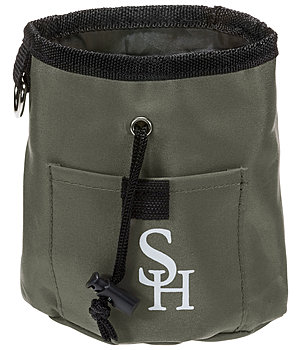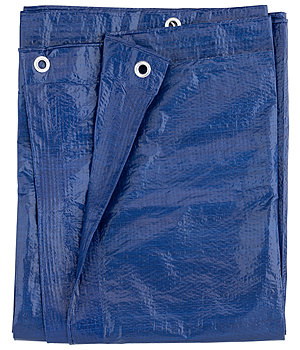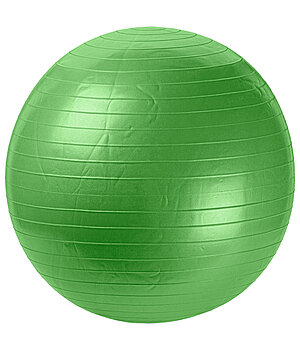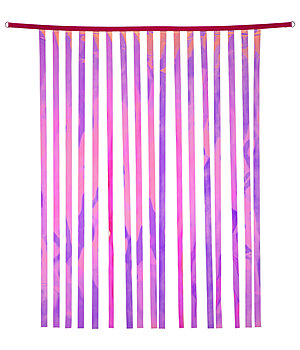Calmness training guide
The challenges that arise when dealing with horses often stem from the fact that horses show instinctive and very pronounced escape behaviour. They perceive their environment differently than humans and for this reason often react more sensitively to the unknown.

It is therefore not uncommon for horses to react with shying, flight or even bucking within seconds when confronted with an unfamiliar noise or object. The physical prerequisites to take flight from one moment to the next are given:
- long legs for maximum stride length and high speeds
- large nostrils and lungs for better oxygen supply
- „Fight-or-flight response“: adrenaline rushes prepare the cardiovascular system for the impending strain
However, before horses flee from danger, they must be able to recognise it in time. With their well-developed sensory organs, they have a perfect „early warning system“. A short excursion into the world of sensory perception makes the horses‘ jumpy behaviour easier to understand:

The eyes
The eyes are located on the side of the head, which means that horses have almost all-round vision, even when they tilt their head down to graze. The disadvantage, however, is that spatial vision is severely limited because the area that both eyes perceive at the same time is very small. This uncertainty in optical perception is also reflected in the horses‘ behaviour – they often react fearfully even when recognising unknown outlines. They „play it safe“ and take flight even before they have the opportunity to take a closer look at the object.
Although spatial vision and colour perception are limited in horses, they have a considerable advantage over us humans at night – in twilight and darkness they manage better than humans due to the so-called tapetum lucidum.
The ears
The horse’s ears are highly sensitive – they perceive an even higher frequency range than humans. Even quiet noises that we do not perceive at all are heard by horses. So it is quite possible that the horse perceives a rustling of leaves in the wind as a threat during a ride in the forest. To localise the sounds, they can turn their ears independently in almost any direction. Ear play is unmistakable in horses – they are almost always on the move to stay alert.


The nostrils
The nostrils are also an important part of detecting potential danger. Horses have a keen sense of smell. They can even „smell“ water holes miles away and use their nostrils to select not only their food but also their contemporaries. With their excellent sense of smell, they compensate for the impairments that monocular vision (= one image per eye) brings.
Through careful calmness training, horses are able to get used to sensory stimuli that initially trigger the flight instinct. There are different approaches and methods for this. However, the horse should always have the opportunity to explore the new sensory stimulus calmly on its own.
Basics of calmness training
Before you start with calmness training, you should set yourself a goal. What do I want to achieve with the training? What objects or sensory stimuli is my horse particularly afraid of?
If a horse repeatedly reacts with fear in a certain situation, e.g. always at the same bush when riding out, the first thing to do is to work on the specific situation. Especially if the horse shows extreme panic and there is a great safety risk for horse and human, it is recommended to consult a professional trainer.

A calmness course in the riding arena with various „frightening objects“ is a good approach to encourage the horse’s curiosity and to keep him motivated to work even with unfamiliar stimuli. It can also simply be integrated into the training schedule as a component of groundwork as a creative change. In principle, work in a composure course is suitable for every horse. However, for horses with corresponding traumas, care should be taken to carry out the training particularly gently and also to work on the triggers first – in difficult cases also with a trainer – before tackling a course.

A first basic requirement for successful composure training is that there is already a certain trust between human and horse and that the order of precedence is clarified, i.e. the human moves the horse and gives it the necessary security and orientation in difficult moments. If you practise regularly in the course, this relationship will be strengthened in the long term.
The scope of the course should be adapted to the current nervous strength of the horse. At the beginning, one „obstacle“ is sufficient, which is explored and worked out together. If the first object has been mastered confidently, you can add another element the next time.
To master the objects, you should consider the following points:
- Remain calm and relaxed yourself.
- Walk around the object with your horse, let him look at it from a distance from all sides.
- Walk together with your horse towards the „obstacle“.
- Pay attention to your horse’s reactions, take breaks if necessary.
- Also occupy yourself intensively with the object. The horse must realise that you are also consciously aware of potential „sources of danger“ and do not ignore them. This will give him a lasting sense of security.
- Let him explore the object in peace. Also accept if it reacts insecurely, e.g. by backing away.
- Touch the object and reassure him that he does not have to be afraid.
- Praise at the right moments, e.g. when it has touched the object.
Whether you just stick to praising or give a treat as a reward is up to you. Other approaches, such as clicker training, are also a possibility. However, it is important not to force anything and to give the horse the necessary trust and calmness to achieve long-term success.
Accessories – what do I need for calmness training?
For the lead training in the calmness course, you can use a conventional headcollar with rope, but special training halters for groundwork as well as groundwork ropes usually enable a better connection to the horse. Of course, you should also wear sturdy shoes and riding gloves for your own safety. If the horse should react fearfully and pull on the rope, this will prevent unpleasant burns.
There are no limits to your creativity when it comes to creating a varied course of composure. Just make sure that the „obstacles“ do not pose a safety or injury risk, e.g. by getting stuck or by protruding elements, etc.


Conceivable objects are:
- Flutter curtain
- Balls curtain
- Tarpaulins
- Balloons
- Umbrella
- Flags
- Rattles
- Balls
- Foam noodles
- Spatial obstacles (gates, horse trailers, water ditches)
- Rattle bags (filled with plastic bottles or empty tin cans)
- Pylons
- seesaws
- Platforms
- and much more.







